Bar counter in the interior of the living room
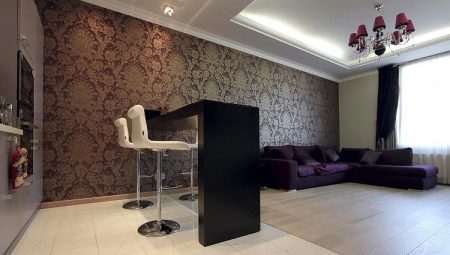
As an independent element of the interior, the bar counter appeared a long time ago. But in the interior of residential premises, it has become fashionable to install it en masse relatively recently. What is this piece of furniture, what options exist - let's talk about this in more detail.
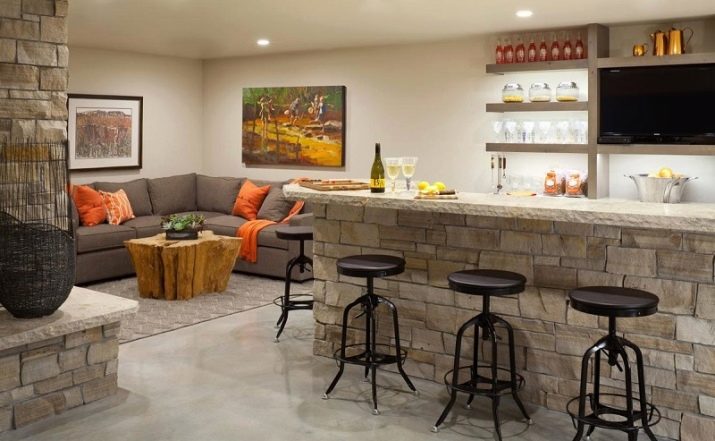
A bit of history
The very concept of "bar counter" comes from the English word "bar", which in translation means "partition". It is believed that bar counters first appeared in North America in the 18th century. However, the first prototypes of bar counters were still in the days of Antiquity in the most enlightened state at that time - Ancient Rome. They were called "thermopolias" and were installed in taverns and other drinking establishments and were intended for heating and serving food.
The first bar counters were a cross between an oven where food was prepared and a trade counter where the food was displayed. Later this idea was taken up by the Greeks, and even later the thermopoly went down in history, but the idea of the counter itself remained. They were still installed in places where food was served. Bar counters were roughly hammered tables on legs, which simultaneously served for cooking and eating food.
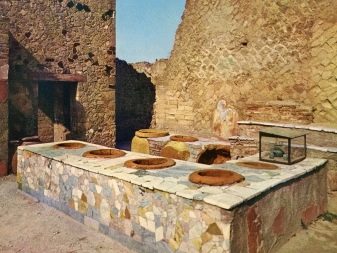
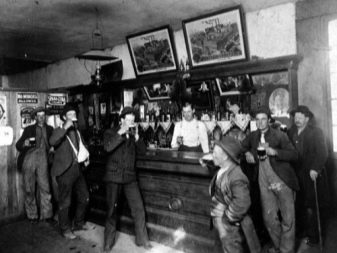
Later still, in the days of the Wild West, when it became necessary to defend against the raging visitors to establishments, who often grabbed their arms, bar counters began to be made in America... They changed somewhat - they became taller, one side began to be nailed with boards, high bar stools appeared. Over time, various devices began to be added to the rack - shelves, hooks and other accessories.The countertop itself expanded and became a full-fledged workplace for the bartender, whose duties included pouring and serving alcoholic beverages.
The idea of the bar counter was so successful that it was picked up in other countries as well. They began to install it in catering establishments, and over time this piece of furniture migrated to private dwellings. Recently, the fashion for home bar counters has become ubiquitous, and modern furniture studios are vying with each other to offer a variety of bar counter options for home decor.
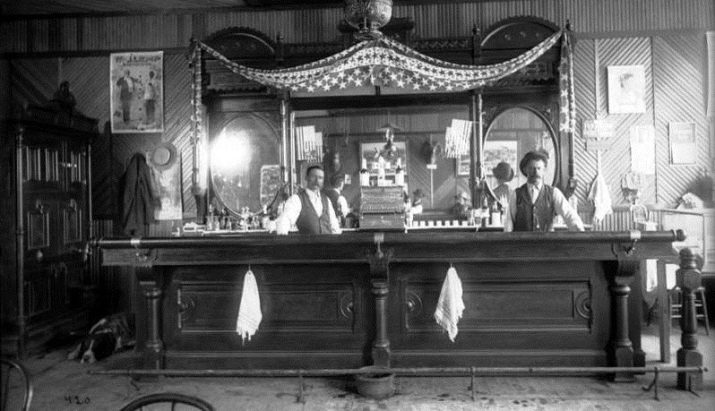
Varieties
The bar counter in the living room interior can perform several functions at once. Its design can be very diverse depending on the size of the room and its purpose. This is a universal solution for a small studio apartment, and for a luxurious living room of a fashionable mansion. In the hall of the apartment or in the living room of a private house, the rack can be installed instead of the interior partition, that is, it can perform the function of zoning the space. Also, this detail can act as a cutting and dining table at the same time. The bar counter can take on a wide variety of shapes and sizes.

Let's consider the most common options.
- Straight. This classic form, this is the kind of stance that existed from the very beginning. The rectangular design fits absolutely any interior, it will fit into a room of any size.

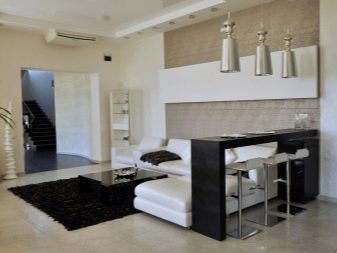
- Corner the counter is usually designed to separate the eating area and the living room itself. It can be an independent piece of furniture or an extension of a kitchen set.
However, due to its somewhat cumbersome structure, it is not suitable for too small rooms.
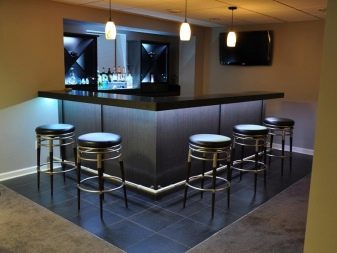

- Rounded - semicircular or round. Both options look very interesting and unbeatable, but their installation also requires a certain amount of free square meters.
It is convenient for large companies to gather at the rounded table.
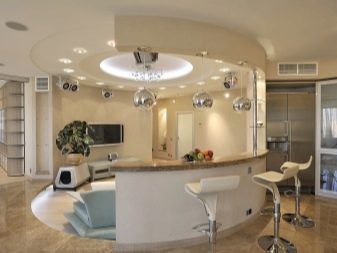

- Retractable the bar counter will be appropriate when there is a shortage of space - in a small living room or studio. If necessary, it can be easily lifted and fixed, and after lunch or dinner it can also be easily folded, freeing up the room.

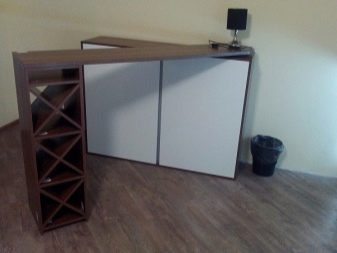
- Folding the table top performs functions similar to the pull-out rack. The only difference is the folding mechanism. Such a stand can be attached directly to a wall or to a kitchen cabinet and, if necessary, easily transforms from a table, for example, into a decorative piece of the interior or into a nightstand door.
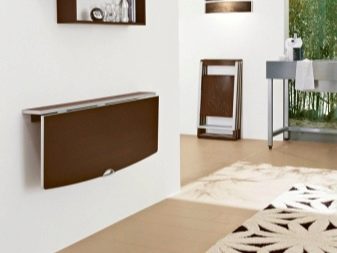
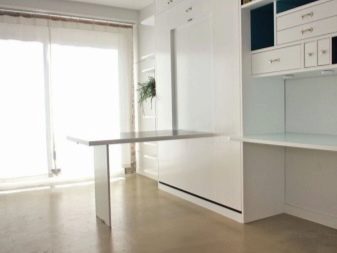
- Two-level. This option is not very common, but this makes it no less attractive. Such a tabletop has two panels located one above the other, one of which serves as a work surface, and the other as the actual dining area.

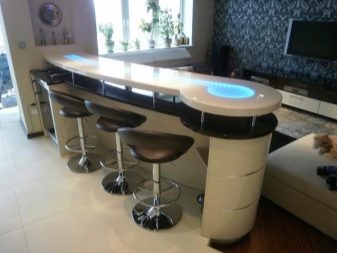
- Open the bar counter assumes the presence of the actual table top and legs. Sometimes there are several shelves below for small items without any covers and doors.
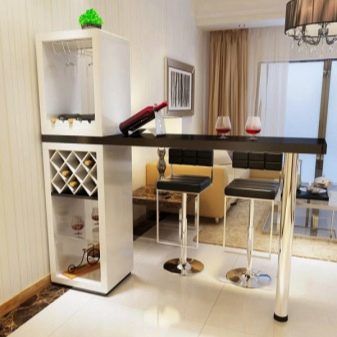
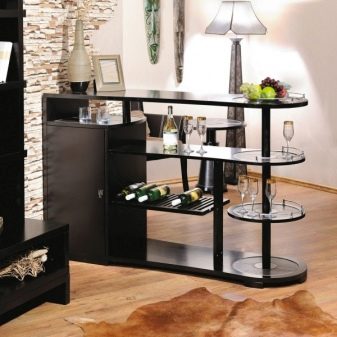
- Closed the counter is more like a bedside table or wall. The bottom can also contain shelves for storing kitchen utensils, some or all of which can be closed with doors.
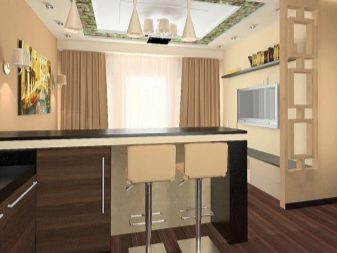
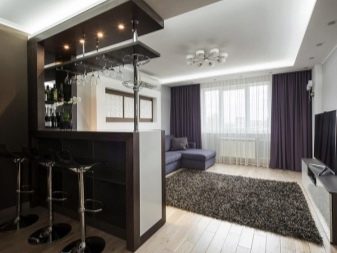
Any bar counter requires chairs. They can also be completely different - with or without a back, with soft seats, with legs or with a rotating stand - the final version depends on the style of the stand itself and the personal preferences of the owners.
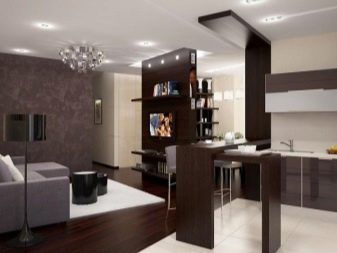
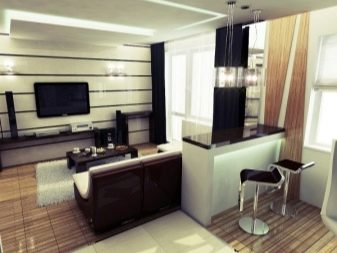
Location
The bar counter was originally intended for a more functional use of the space, so it should be installed so that it does not interfere with the passage. The following placement options are most common.
- Behind the back of a sofa or chair, when the person sitting at the counter will be behind the back of the person sitting on the couch. This option is convenient in a room that is also a home theater. A TV or screen is usually located in front of those sitting.
You can safely cook while talking to family members.
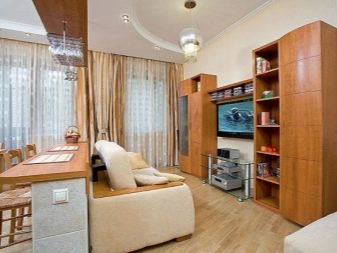

- Between the kitchen and the living room. This arrangement is often used in open-plan apartments or where these 2 rooms are combined into a single space.
A wide table top can replace a dining table, and a narrow one will be an interesting decor element.
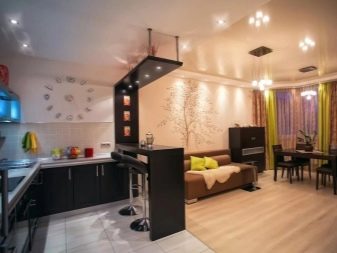
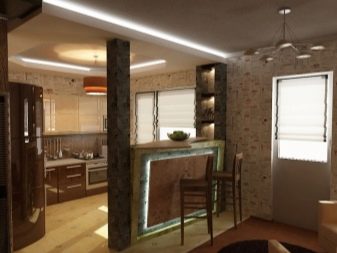
- Between the room and the balcony (loggia). Often, the owners of small apartments increase the usable area by joining a loggia or balcony to the room. In this case, the bar counter can be both a table and a curbstone, and a flower stand, and a work cabinet at the same time, and also perform many different functions.
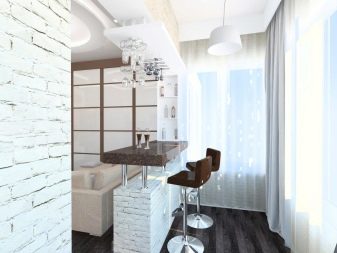
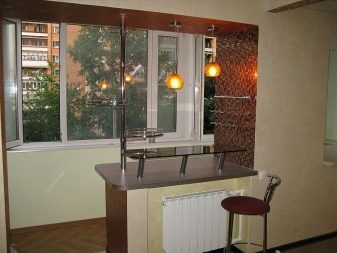
- Near the window. If it is located high from the floor, the table top can be a continuation of the window sill, but if it is low, you can comfortably sit on it not only with a glass of champagne, but also with a laptop.
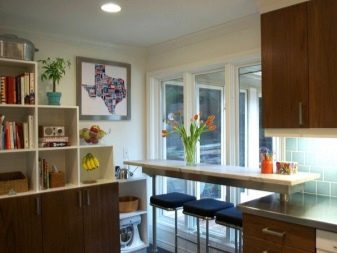

- Wall stand especially relevant in a narrow living room, where there is no way to put a full kitchen or writing table.
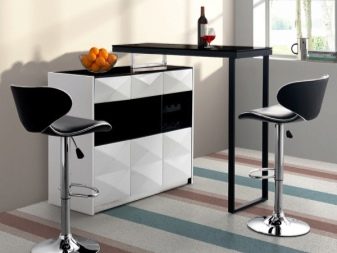
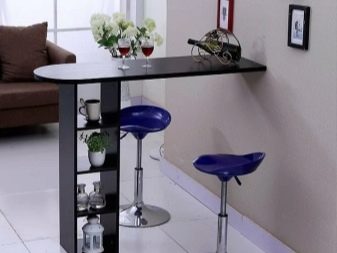
- In the center of the living room. This arrangement takes place only in large halls. This is very convenient, since the counter can be approached from any part of the room, and a large number of people can be accommodated behind it.

Stylistic directions
The bar counter should not be a foreign body in the hall; it should harmoniously fit into the surrounding environment. Depending on the style of the interior, the following directions can be distinguished.
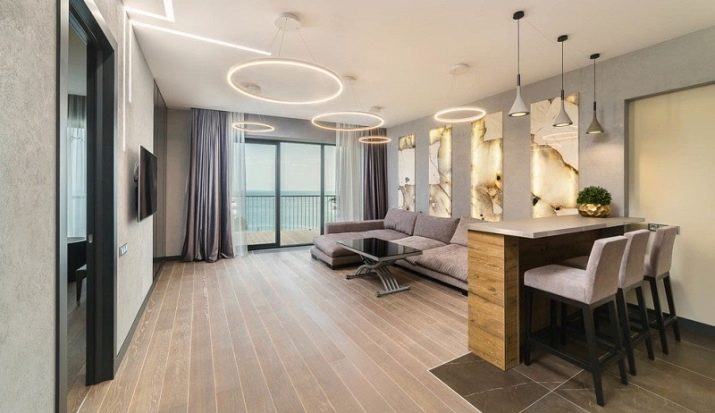
Classic
This style is characterized by the use of precious woods - solid wood for the main details and veneer for decoration. In a more budgetary version, MDF or chipboard is allowed. Such furniture will easily fit into almost any interior. There are elegantly shaped chairs, often with upholstered seats.
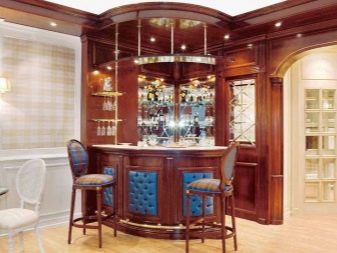
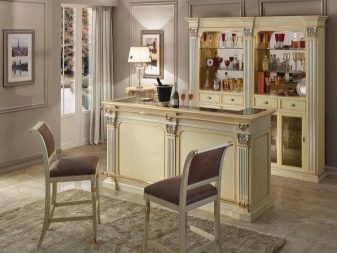
Country
This style is an echo of those distant times, when cowboys fought between themselves, and the stand served as a kind of shield. The country-style stand is also made from natural materials: wood or stone. For decorative finishing, you can use natural fabrics with natural ornaments. Chairs or stools are solid, simple, rough in shape, preferably made of wood.


Disco
An abundance of bright plastic details, shiny metal, and artificial leather are appropriate here. One-piece plastic chairs with a swivel leg, neon lighting and a sparkling mirror ball above the bar act as a good addition.
This style is appropriate in an apartment where young people live who love noisy fun parties.
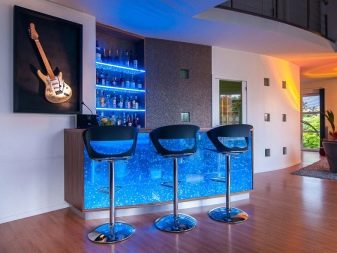
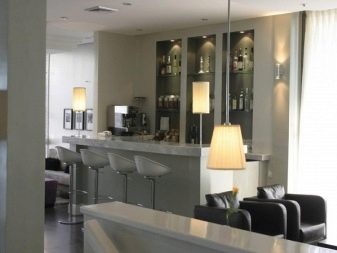
Loft
Deliberate roughness, rough surfaces and moderate colors are inherent in this style. The bar counter looks more like a locksmith's machine than a meal table. To achieve the desired effect, surfaces are sometimes artificially aged. The chairs are high, knocked together as if in a hurry. The material of manufacture is usually wood, chrome and nickel. Wooden parts must first be impregnated with wood stain and covered with several layers of varnish, as they will come into contact with water.
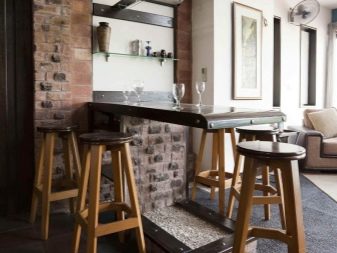
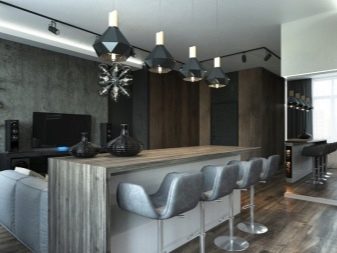
Modern
This option is somewhat reminiscent of the "disco" style, but more elegant and practical. All details of a modern bar counter must be extremely practical and functional. The frame is rigid, regular in shape, with clear lines.
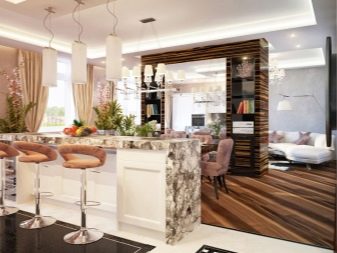
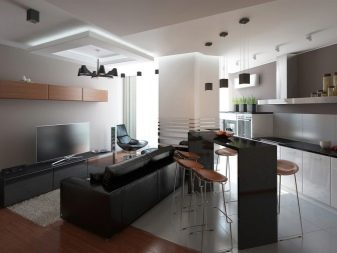
Provence
This direction in the interior is sometimes called rustic. Plastic and other artificial materials are categorically excluded here. The support for the rack can be made of wood, the table top is made of stone, and the handles and other fittings can be made of ceramics or metal alloys. As a decoration, you can use linen napkins, straw cup holders and other cute things. Sincerity and simplicity are the main foundations of this style.
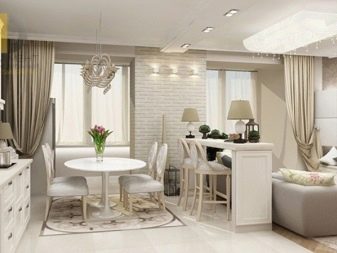
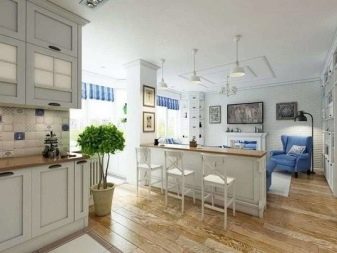
High tech
The opposite of the previous direction. This is the kingdom of plastic, glass and metal, acid colors, chrome parts.The stand can be supplemented with a visor with fluorescent lighting or a metal glass stand.
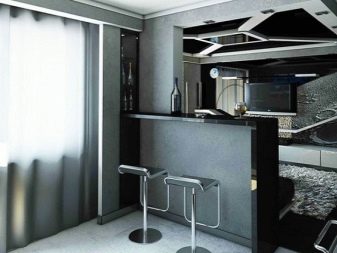
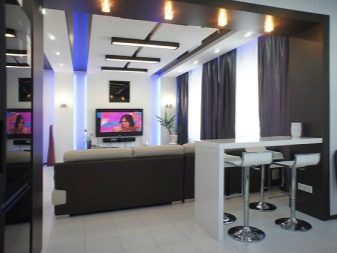
Whatever style of bar you choose for your living room, it can be a great alternative to a banal dining table.
You can find out how to make a bar counter with your own hands by watching the video below.








